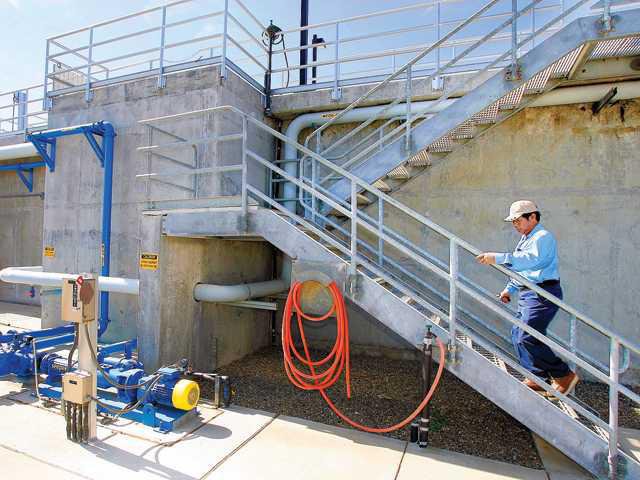There’s a new gas station that may be coming to Manteca.
But you won’t be able to buy standard gasoline or diesel there. Nor are you likely to be able to buy chips, soda, or candy when you fill up.
And it won’t be very hard to find. All you have to do is look for a one megawatt solar facility.
When the city finishes its bio-gas plant that will convert food waste and byproducts of the wastewater treatment process in 18 months or so to produce compressed natural gas, there may be a public fueling station included as part of the facility.
Public Works Director Mark Houghton talked about the possibility of the public being able to buy gas made from recycled food waste at the treatment plant located on West Yosemite Avenue south of the Altamont Corridor Express train station during last week’s Manteca Council mid-year budget review workshop. He also discussed the solar farm that will be built later this year at the treatment plant.
Food waste from Manteca and Tracy — and possibly other San Joaquin County jurisdictions — will be hauled to the bio-gas conversion facility as part of the food-to-energy project. It will involve placing a device known as a Turbo Separator at the Lovelace Transfer station north of Manteca that will allow organic waste to be separated mechanically from other trash. Many operations separate food waste from trash by hand.
Large generators of food waste — schools, grocery stores, restaurants, and hospitals — will be placing food waste in locked orange bins on collection days. So far, the City of Manteca has three schools — Woodward, Brock Elliott, and Joshua Cowell — separating food waste. They are collecting an average of a ton a week of food waste just from the three schools. All schools in Manteca Unified will be doing the same by the end of the year as well as large commercial operations throughout the City of Manteca.
The food waste for now is being taken to Harvest Power in Lathrop where it is converted into compost.
The city already has four compressed natural gas (CNG) powered solid waste collection trucks in service along with three hybrid trucks. Eventually all two dozen trucks will be replaced with those using CNG gas.
The city is currently buying CNG fuel from a private Lathrop station until such time their bio-gas conversion is up and running. The design of the bio-gas facility and receiving station is 90 percent completed.
Solar power farm
at treatment plant
The city expects to advertise for bids for the one megawatt solar plant in April.
It will be located on the west side of the access road along the Union Pacific tracks and Yosemite Avenue.
When it is installed, it will be the second largest single solar installation operated by a South County government agency.
It will supply roughly a third of the electricity needed to run the wastewater treatment plant. The city’s current PG&E bill for the treatment plant is $1.2 million on an annual basis.
The solar plant based on 2015 estimates has an eight year payback while the life expectancy is 25 years. That means for 17 years the city will be getting free electricity.
Electricity is the highest cost involved in running the wastewater treatment plant.
The largest single solar installation serving the South County is the 1.6-megawatt Robert Schulz Solar farm operated by the South San Joaquin Irrigation District to provide almost all the power needed for the surface water treatment plant that provides water to Manteca, Lathrop, and Tracy. It is helping to keep costs down for drinking water in the three cities.
The largest aggregate solar installation, though, are all the panels operated at various Manteca Unified School District sites.
The solar panels generated 27 percent of the district’s power needs in 2013-14 saving roughly $500,000.
When the bio-gas facility and solar farm are completed it will bring the number of green initiatives at the wastewater treatment plant to three.
Construction firms started using a purple fire hydrant this year to secure treated wastewater for dust control at construction sites instead of using city drinking water.
FILL UP AT MANTECA
Public may be able to buy fuel made from city food waste



